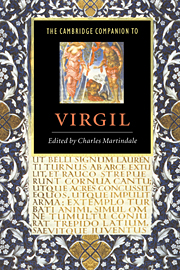Book contents
- Frontmatter
- Contents
- List of illustrations
- List of contributors
- Preface
- 1 Introduction: ‘The classic of all Europe’
- Part 1 Translation and reception
- Part 2 Genre and poetic career
- Part 3 Contexts of production
- Part 4 Contents and forms
- 16 Virgil's style
- 17 Virgilian narrative (a) Story-telling
- 17 Virgilian narrative(b) Ecphrasis
- 18 Approaching characterisation in Virgil
- 19 Sons and lovers: sexuality and gender in Virgil's poetry
- 20 Virgil and tragedy
- 21 Envoi: the death of Virgil
- Dateline compiled by Genevieve Liveley
- List of works cited
- Index
- Plates
20 - Virgil and tragedy
from Part 4 - Contents and forms
Published online by Cambridge University Press: 28 May 2006
- Frontmatter
- Contents
- List of illustrations
- List of contributors
- Preface
- 1 Introduction: ‘The classic of all Europe’
- Part 1 Translation and reception
- Part 2 Genre and poetic career
- Part 3 Contexts of production
- Part 4 Contents and forms
- 16 Virgil's style
- 17 Virgilian narrative (a) Story-telling
- 17 Virgilian narrative(b) Ecphrasis
- 18 Approaching characterisation in Virgil
- 19 Sons and lovers: sexuality and gender in Virgil's poetry
- 20 Virgil and tragedy
- 21 Envoi: the death of Virgil
- Dateline compiled by Genevieve Liveley
- List of works cited
- Index
- Plates
Summary
Since antiquity Virgil the epicist has also been viewed as Virgil the tragedian; Martial describes him simply as Maro cothurnatus, 'Virgil in buskins' (5.5.8, 7.63.5). The task of collecting the numerous parallels between the Aeneid and tragedies both Attic and Roman was well under way by the time of the late-antique commentators Servius and Macrobius. But why should the poet who set out to write the definitive Roman epic include so many elements from the distinct (if historically related) genre of tragedy?
A recent study shows the inseparability of formal study of tragic sources for the Aeneid from wider questions of interpretation. Oliver Lyne exploits an allusion to the Sophoclean Ajax in the characterisation of Aeneas to reinforce a prevalent modern reading of the Aeneid as a 'tragic' (with a small 't') poem: 'a further [non-epic] voice naggingly insinuates a quite different message', a message that makes of the poem a pessimistic, even subversive and anti-Augustan epic. Here the opposition of 'epic' and 'tragic' implies a conflict between the Aeneid's function as a public panegyric of Roman history and the valuation to be given to the private experience of loss and grief.
- Type
- Chapter
- Information
- The Cambridge Companion to Virgil , pp. 312 - 326Publisher: Cambridge University PressPrint publication year: 1997
- 11
- Cited by



